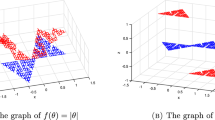Abstract
The generalized functional equations describing a wide class of different self-similar processes are derived. These equations follow from the observation that microscopic function describing an initial self-similar process increases monotonically or even cannot have a certain value. The last case implies the behavior of trigonometric functions cos(zζ n), sin(zζ n) at ζ > 1 and n ≫ 1 that can enter to the microscopic function and when the limits of the initial scaling region are increasing and becoming large. The idea to obtain the desired functional equations is based on the approximate decoupling procedure reducing the increasing microscopic function to the linear combination of the same microscopic functions but having smaller scales. Based on this idea the new solutions for the well-known Weierstrass-Mandelbrot function were obtained. The generalized functional equations derived in this paper will help to increase the limits of applicability in description of a wide class of self-similar processes that exist in nature. The procedure that is presented in this paper allows to understand deeper the relationship between the procedure of the averaging of the smoothed functions on discrete self-similar structures and continuous fractional integrals.
Similar content being viewed by others
References
A. A. Arbuzov, R.R. Nigmatullin, Three-dimensional fractal models of electrochemical processes. Russian J. of Electrochemisty 45 (2009), 1377–1387.
D. Baleanu, J.A.T. Machado, A. Luo (Eds.), New Trends in Nanotechnology and Fractional Calculus Applications. Springer (2010).
G.I. Barenblatt, Scaling, Self-Similarity, and Intermediate Asymptotics. Cambridge University Press (1996).
E. Capelas de Oliveira, F. Mainardi, J. Vaz Jr., Models based on Mittag-Leffler functions for anomalous relaxation in dielectrics. Eur. Phys. J. Special Topics 193 (2011), 161–171.
J. Feder, Fractals. New York, Plenum Press, p. 283 (1988).
B. Mandelbrot, The Fractal Geometry of Nature. W.H. Freeman, San Francisco (1982).
A. Le Mehaute, R.R. Nigmatullin, L. Nivanen, Fleches du temps et geometrie fractale. Paris, Editions Hermes (in French) (1998).
R. R. Nigmatullin, A. Le Mehaute, Is there a geometrical/physical meaning of the fractional integral with complex exponent ? Journal of Non-Crystalline Solids 351 (2005), 2888–2899.
R. R. Nigmatullin, Theory of dielectric relaxation in non-Crystalline solids: From a set of micromotions to the averaged collective motion in the mesoscale region. Physica B: Physics of Condensed Matter 358 (2005), 201–215.
R. R. Nigmatullin, Dielectric relaxation based on the fractional kinetics: Theory and its experimental confirmation. Physica Scripta T136 (2009), 014001.
R. R. Nigmatullin, S.O. Nelson, Recognition of the fractional kinetic equations from complex systems: Dielectric properties of fresh fruits and vegetables from 0.01 to 1.8 GH. Signal Proc. 86 (2006), 2744–2759.
R. R. Nigmatullin, A.A. Arbuzov, F. Salehli, A. Gis, I. Bayrak, H. Catalgil-Giz, The first experimental confirmation of the fractional kinetics containing the complex power-law exponents: Dielectric measurements of polymerization reaction. Physica B: Physics of Condensed Matter 388 (2007), 418–434.
R. R. Nigmatullin, Strongly correlated variables and existence of the universal disctribution function for relative ffluctuations. Physics of Wave Phenomena 16, No 2 (2008), 119–145.
R. R. Nigmatullin, A.P. Alekhin, Calculation of a static potential created by plane fractal cluster. p. 41. In: Proc. of 3-rd Conference of Nonlinear Science and Complexity (Ankara, July 28–31, 2010), p. 41.
J. Sabatier, O.P. Agrawal, J.A. Tenreiro Machado (Eds.), Advances in Fractional Calculus. Springer, (2007).
D. Sornette, Discrete scale invariance and complex dimensions. Physics Reports 297 (1998), 239–270.
V. Uchaikin, R. Sibatov, Fractional Kinetics in Solids: Anomalous Charge Transport in Semiconductors, Dielectrics and Nanosystems. World Sci. Publ., Singapore (2012).
Author information
Authors and Affiliations
Corresponding author
About this article
Cite this article
Nigmatullin, R.R., Baleanu, D. The derivation of the generalized functional equations describing self-similar processes. fcaa 15, 718–740 (2012). https://doi.org/10.2478/s13540-012-0049-5
Received:
Published:
Issue Date:
DOI: https://doi.org/10.2478/s13540-012-0049-5




